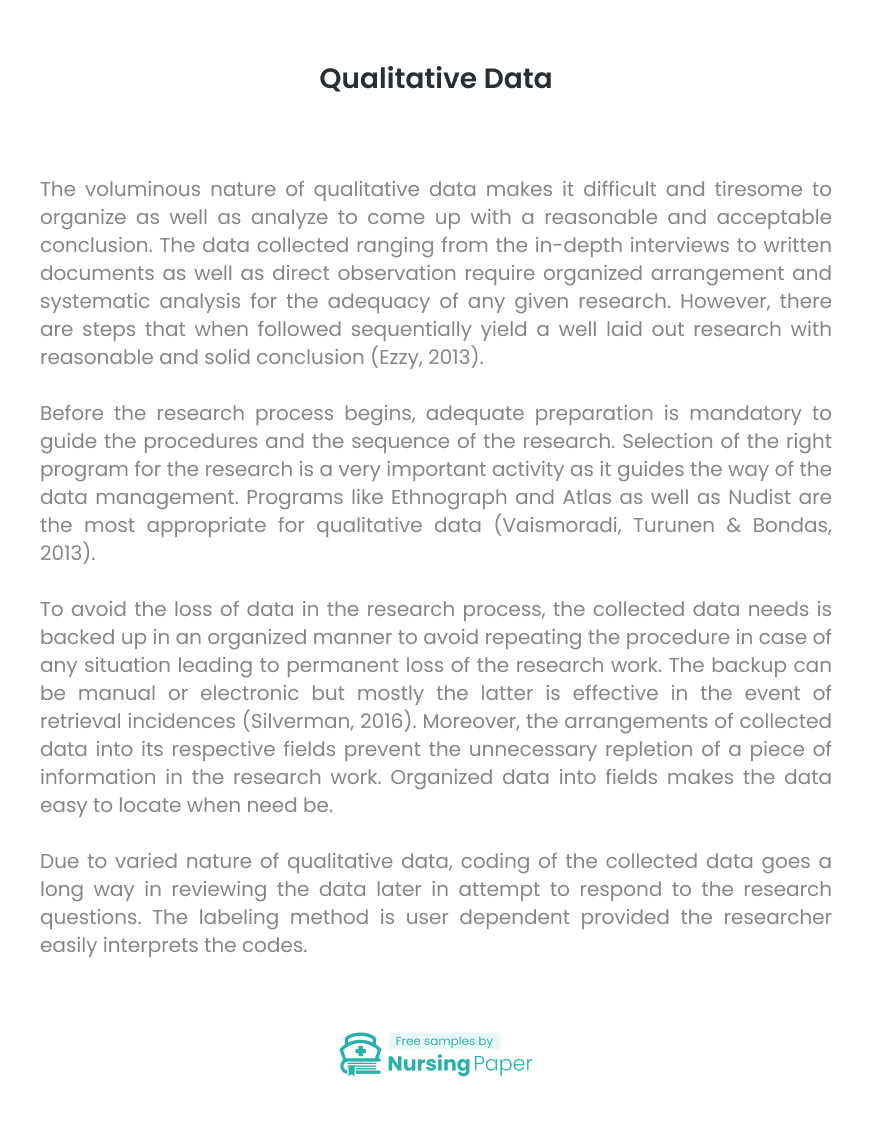
Qualitative Data
Part One
The voluminous nature of qualitative data makes it difficult and tiresome to organize as well as analyze to come up with a reasonable and acceptable conclusion. The data collected ranging from the in-depth interviews to written documents as well as direct observation require organized arrangement and systematic analysis for the adequacy of any given research. However, there are steps that when followed sequentially yield a well laid out research with reasonable and solid conclusion (Ezzy, 2013).
Before the research process begins, adequate preparation is mandatory to guide the procedures and the sequence of the research. Selection of the right program for the research is a very important activity as it guides the way of the data management. Programs like Ethnograph and Atlas as well as Nudist are the most appropriate for qualitative data (Vaismoradi, Turunen & Bondas, 2013).


Part Two
To avoid the loss of data in the research process, the collected data needs is backed up in an organized manner to avoid repeating the procedure in case of any situation leading to permanent loss of the research work. The backup can be manual or electronic but mostly the latter is effective in the event of retrieval incidences (Silverman, 2016). Moreover, the arrangements of collected data into its respective fields prevent the unnecessary repletion of a piece of information in the research work. Organized data into fields makes the data easy to locate when need be.
Due to varied nature of qualitative data, coding of the collected data goes a long way in reviewing the data later in attempt to respond to the research questions. The labeling method is user dependent provided the researcher easily interprets the codes. Proper selection of the research program, backing up the data and organizing the data into the right fields help in the management and organization of the research data and make the process less tiresome and voluminous (Ezzy, 2013).
1. Ezzy, D (2013). Qualitative analysis. London : Routledge, Print
2. Silverman, D. (Ed.). (2016). Qualitative research. New York, Sage, Print.
3. Vaismoradi, M., Turunen, H., & Bondas, T. (2013). Content analysis and thematic analysis: Implications for conducting a qualitative descriptive study. Nursing & health sciences, 15(3), 398-405



The download will start shortly.

The download will start shortly.
 Subject:
Medicine
Subject:
Medicine  Number of pages: 3
Number of pages: 3  Subject:
Health and Social Care
Subject:
Health and Social Care  Number of pages: 2
Number of pages: 2  Subject:
Health and Social Care
Subject:
Health and Social Care  Number of pages: 4
Number of pages: 4  Subject:
Nursing
Subject:
Nursing  Number of pages: 5
Number of pages: 5  Subject:
Medicine
Subject:
Medicine  Number of pages: 3
Number of pages: 3  Subject:
Medicine
Subject:
Medicine  Number of pages: 2
Number of pages: 2  Subject:
Health and Social Care
Subject:
Health and Social Care  Number of pages: 3
Number of pages: 3  Subject:
Medicine
Subject:
Medicine  Number of pages: 6
Number of pages: 6  Subject:
Health and Social Care
Subject:
Health and Social Care  Number of pages: 2
Number of pages: 2  Subject:
Health and Social Care
Subject:
Health and Social Care  Number of pages: 6
Number of pages: 6  Subject:
Health and Social Care
Subject:
Health and Social Care  Number of pages: 3
Number of pages: 3  Subject:
Medicine
Subject:
Medicine  Number of pages: 2
Number of pages: 2  Subject:
Nursing
Subject:
Nursing  Number of pages: 3
Number of pages: 3  Subject:
Medicine
Subject:
Medicine  Number of pages: 2
Number of pages: 2  Subject:
Nursing
Subject:
Nursing  Number of pages: 5
Number of pages: 5 
